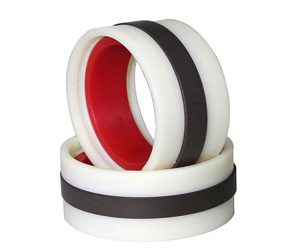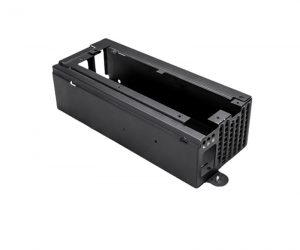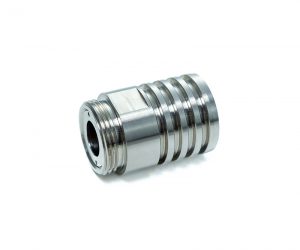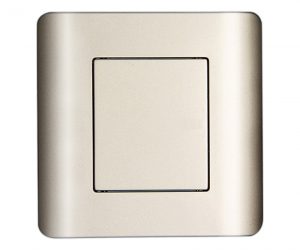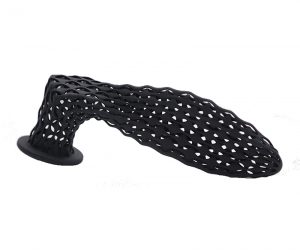The ubiquitous plastic gear: a deceptively simple component whose performance transcends its seemingly mundane nature. While superficially resembling their metallic counterparts, plastic gears represent a sophisticated convergence of material science and engineering design, enabling functionalities previously unattainable. This analysis delves beyond superficial observations, exploring the intricate interplay of material properties, manufacturing processes, and application-specific design considerations that define the exceptional performance and versatility of plastic gears.
The inherent characteristics of plastic gears stem from the strategic selection of high-performance engineering polymers. These materials, far from being mere substitutes for metals, offer a unique constellation of properties. Their lightweight nature, crucial in applications demanding minimized inertia and enhanced energy efficiency, is counterbalanced by surprisingly high tensile strength and impact resistance – characteristics often exceeding those of certain metal alloys. Furthermore, the inherent corrosion resistance of many engineering plastics renders them impervious to degradation in chemically aggressive environments, significantly extending operational lifespan and reducing maintenance requirements. This inherent resistance to degradation is further amplified by the inherent self-lubricating properties of many polymer formulations, minimizing friction and wear, thus contributing to both extended operational life and enhanced energy efficiency. The surface smoothness, while seemingly trivial, significantly reduces particulate accumulation, further enhancing operational reliability and reducing the need for frequent cleaning.
The advantages of plastic gears extend beyond mere material properties. Their inherent shock-absorbing capacity mitigates the transmission of vibrations and impacts, resulting in a quieter, more stable, and ultimately more reliable system. This inherent damping characteristic is particularly advantageous in high-speed applications or those subjected to frequent shock loads. The reduced noise profile, a direct consequence of both material properties and design optimization, is a significant advantage in noise-sensitive environments. The inherent design flexibility of plastic gears also allows for intricate geometries and complex internal structures, unattainable with traditional metal-casting techniques. This enables the creation of highly specialized gears optimized for specific applications, pushing the boundaries of performance and efficiency.
The application landscape for plastic gears is vast and ever-expanding. Their presence extends far beyond the commonly cited automotive, aerospace, and electronics sectors. In the automotive industry, their role extends beyond power windows and air conditioning systems; they are integral components in increasingly sophisticated powertrain systems, advanced driver-assistance systems (ADAS), and even in critical safety mechanisms. Aerospace applications leverage their lightweight yet robust nature in high-performance actuators, control systems, and even in structural components where weight reduction is paramount. The electronics industry utilizes their precision and low friction in micro-robotics, medical devices, and high-precision instrumentation. Beyond these established sectors, plastic gears are finding increasing applications in renewable energy systems, industrial automation, and even in high-end consumer products.
In conclusion, the seemingly simple plastic gear represents a remarkable achievement in materials science and engineering. Its performance transcends its humble appearance, offering a compelling combination of lightweight design, high strength, exceptional durability, and remarkable versatility. A deeper understanding of the underlying material science and design principles is crucial to fully exploit the potential of these remarkable components, enabling their continued integration into increasingly sophisticated and demanding applications across diverse industries.
The Unpredictable World of Plastic Pinion Gears: A Deep Dive into Material Science and Application
Plastic pinion gears, seemingly mundane components, represent a fascinating intersection of material science, mechanical engineering, and often, the unexpected. Their ubiquitous presence in diverse systems, from the intricate mechanisms of medical devices to the seemingly simple operation of children's toys, belies a complexity rarely appreciated. This exploration delves beyond superficial descriptions, examining the nuanced interplay of material properties, operational limitations, and the surprising ways in which these seemingly simple gears defy expectations.
Deconstructing the Plastic Gear Paradigm:
2.1 Beyond Simple Rotation: Plastic gears are not merely passive transmitters of rotational motion; they are active participants in a complex dance of forces, stresses, and material degradation. The choice of polymer—be it the robust resilience of nylon 66, the dimensional stability of acetal (POM), the impact resistance of polycarbonate (PC), or the emerging bio-based alternatives—fundamentally alters the gear's performance profile. This selection is not arbitrary; it's a carefully calibrated response to the specific demands of the application, often involving intricate trade-offs between strength, wear resistance, and cost. Furthermore, the manufacturing process itself—injection molding, extrusion, or even additive manufacturing—introduces further variability and potential for unexpected behavior.
2.2 The Unseen Advantages and Unforeseen Disadvantages: The commonly cited advantages—low noise, self-lubrication, cost-effectiveness, and corrosion resistance—represent only a fraction of the story. The self-lubricating properties, for instance, are not uniform across all polymers and are highly dependent on operational parameters such as load, speed, and ambient conditions. Similarly, the "low cost" advantage can be deceptive; while the raw material cost might be lower, the potential for premature failure can lead to unexpectedly high lifecycle costs. Furthermore, the seemingly predictable behavior of plastic gears can be dramatically altered by factors such as moisture absorption, UV degradation, and thermal cycling, leading to unpredictable performance degradation over time.
Pinion Gears: A Microcosm of Material Complexity:
3.1 Beyond the Rack and Pinion: The interaction between a plastic pinion gear and its mating rack is far from straightforward. The inherent flexibility of plastic, unlike the rigidity of metal, introduces complexities in meshing, leading to potential for increased wear, vibration, and even unexpected gear slippage under specific load conditions. This interaction is further complicated by the often-overlooked influence of manufacturing tolerances and the inherent variability in material properties.
3.2 Material Selection: A High-Stakes Gamble: The choice of nylon, acetal, or polycarbonate for a pinion gear is not simply a matter of selecting the "best" material. It's a strategic decision weighed against a complex matrix of factors, including the required load capacity, operating speed, environmental conditions, and, critically, the cost constraints. The seemingly minor variations in polymer grade or additive packages can dramatically impact the gear's lifespan and reliability. For example, the addition of fillers or lubricants can improve certain properties but may compromise others, introducing a degree of unpredictability into the system's overall performance.
This exploration only scratches the surface of the complexities inherent in plastic pinion gears. Further research into the intricate interplay of material science, manufacturing processes, and operational parameters is crucial to fully unlock their potential and mitigate their inherent unpredictability. The future of plastic pinion gears lies not in simply improving existing materials, but in developing a deeper understanding of their limitations and exploiting their unique properties in innovative and unexpected ways.
the Performance and Unpredictable Behavior of Plastic Pinion Gears
The seemingly innocuous plastic pinion gear belies a complex interplay of material science, mechanical engineering, and operational unpredictability. While often lauded for their straightforward applications, a nuanced understanding reveals a performance profile far more intricate than initially perceived.
4.1 Deconstructing the Performance Paradox: Beyond the Expected
The conventional wisdom surrounding plastic pinion gear performance—lightweight, low friction, and shock-absorbing—presents an incomplete picture. While these characteristics hold true under nominal operating conditions, the actual performance envelope is significantly broader and often characterized by non-linear behavior.
a. Weight Advantage, Structural Vulnerability: The inherent lightness, while advantageous in mobile applications, necessitates careful consideration of structural integrity. Fatigue failure under cyclic loading, particularly in high-stress environments, presents a significant design challenge, demanding sophisticated finite element analysis (FEA) to predict potential failure points and optimize geometries for enhanced durability.
b. Friction's Fickle Nature: The low coefficient of friction, a desirable attribute, is not a constant. It exhibits a complex dependence on factors such as temperature, humidity, and the specific polymer used. Furthermore, the frictional behavior can transition from a benign regime to one characterized by stick-slip phenomena under certain loading conditions, leading to unpredictable oscillations and potential system instability.
c. Shock Absorption: A Double-Edged Sword: While plastic gears effectively absorb shocks, this energy dissipation mechanism can lead to material degradation over time, particularly under repeated impact loading. The viscoelastic nature of the polymers employed introduces further complexity, with the damping characteristics being both frequency and temperature dependent. This necessitates a rigorous understanding of the operational stress spectrum to predict long-term performance and service life.
4.2 Applications: Navigating the Complexities of Diverse Environments
The applications of plastic pinion gears extend far beyond the typical examples. However, successful implementation requires a deep understanding of the material limitations and the potential for unexpected failure modes.
a. Automotive: Beyond the Periphery: While commonly found in ancillary systems, the use of plastic pinion gears in critical automotive components is increasing, albeit cautiously. The need for rigorous testing and validation to ensure reliability and safety under extreme operating conditions (temperature fluctuations, vibrations, and chemical exposure) is paramount.
b. Robotics: Precision Compromised? The precision motion control often associated with robotic applications demands high repeatability and predictability. The inherent variability in plastic gear performance, particularly under varying loads and environmental conditions, necessitates sophisticated control algorithms to compensate for these uncertainties and maintain accuracy.
c. Consumer Electronics: A Balancing Act: The cost-effectiveness of plastic gears is a major driver in consumer electronics. However, the trade-off between cost and reliability must be carefully considered. The potential for premature wear, noise generation, and unexpected failures necessitates robust design and quality control measures.
d. Medical Equipment: Sterilization Challenges: While corrosion resistance is a benefit, the compatibility of certain plastics with sterilization processes must be meticulously evaluated. The potential for degradation of material properties during sterilization can significantly impact the longevity and safety of the medical device.
e. Industrial Machinery: Pushing the Limits: The use of plastic pinion gears in industrial machinery often pushes the boundaries of their performance envelope. The need for robust design, rigorous testing, and advanced predictive maintenance strategies becomes critical to ensure operational reliability and minimize downtime.
Conclusion: Embracing the Unpredictability
Plastic pinion gears offer a compelling combination of advantages, but their performance is not without its complexities and unpredictable facets. A thorough understanding of material behavior, environmental influences, and potential failure modes is essential for successful design and implementation across diverse applications. The future of plastic pinion gear technology lies in advanced material science, sophisticated modeling techniques, and a paradigm shift towards embracing and managing the inherent uncertainties of these versatile components.
What Is the Material of Pinion Gear?
Pinion gears can be made from different materials, including metal and plastic. However, plastic pinion gears are commonly manufactured using materials such as nylon, acetal (POM), or polycarbonate (PC). These materials offer specific advantages in terms of strength, durability, wear resistance, dimensional stability, and temperature resistance.
A pinion gear is a round gear that is usually smaller than the other gear it meshes with. Pinion gears are used in various applications, such as drivetrains, rack and pinion systems, and differentials. The material of a pinion gear depends on the type of application, the size of the gear, and the required strength and durability. Some common materials for pinion gears are:
- Cast steel: This is a type of steel that is formed by pouring molten metal into a mold. Cast steel is typically through-hardened, meaning that it has a uniform hardness throughout the whole piece. Cast steel is used for large gears that need high strength and resistance to wear and fatigue.
- Rolled steel: This is a type of steel that is formed by rolling metal into sheets or bars. Rolled steel can be fabricated into various shapes and sizes by cutting, bending, or welding. Rolled steel is also through-hardened and has similar properties to cast steel.
- Spheroidal graphitic iron: This is a type of iron that has a spherical shape of graphite embedded in the metal matrix. Spheroidal graphitic iron has high ductility, toughness, and resistance to shock and vibration. It is used for large gears that need to withstand high loads and stresses.
- Carburized steel: This is a type of steel that undergoes a heat treatment process called carburizing, which involves adding carbon to the surface layer of the metal. Carburizing increases the hardness and wear resistance of the surface layer, while leaving the core softer and more ductile. Carburized steel is used for pinion gears that need high surface durability and low core strength.
- Induction-hardened steel: This is a type of steel that undergoes a heat treatment process called induction hardening, which involves heating the metal with an electromagnetic field and then quenching it rapidly. Induction hardening creates a hard and wear-resistant surface layer, while leaving the core unaffected. Induction-hardened steel is used for pinion gears that need high surface durability and high core strength.
- Stainless steel: This is a type of steel that contains chromium, which forms a thin layer of oxide on the surface of the metal. This layer protects the metal from corrosion and rusting, especially in saltwater conditions. Stainless steel is used for pinion gears that need high strength and durability in harsh environments.
plastic pinion gears are a versatile and reliable solution for various mechanical systems. Their material composition, performance characteristics, and applications make them an excellent choice in many industries. With their unique advantages and advancements in plastic gear technology, these gears continue to play a crucial role in driving innovation and efficiency in numerous sectors.
Plastic pinion gears are super handy little parts that you’ll find in lots of different places. They’re used in cars, robots, our gadgets, and big machines at work too. These gears are made from strong plastics like nylon, acetal, and polycarbonate. Why? Because they’re tough, last long, and don’t wear out easily. That’s why everyone loves using them these days!
Plastic gears are super lightweight and quiet, which makes them awesome for lots of different applications. They’re also self-lubricating, so you don’t have to worry about constant maintenance. Plus, they’re way cheaper than metal gears, making them a smart choice for businesses watching their budget.
These plastic pinion gears, made from materials like nylon, acetal, or polycarbonate, can handle tough environments without breaking a sweat. They don’t rust, which means they last longer and perform better in corrosive conditions.
